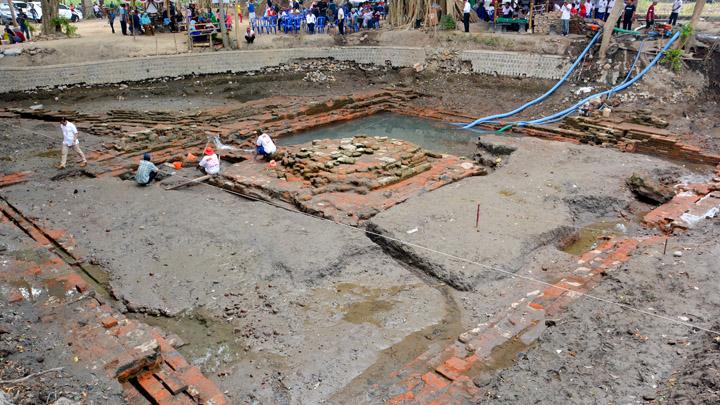
TEMPO.CO, Jakarta - The Sungai Karang Mumus School is encouraging the community to preserve their river. The local habit of disposing trash in the river is the school's biggest challenge.
Misman is often saddened when he observes the Karang Mumus, a tributary of the Mahakam River that runs 34.7 kilometers in East Kalimantan. The 58-year-old man who lives in Muang village, Tanah Datar Regency, has a profound love for the river, where he and his friends played and swam as children. "Karang Mumus was so clean, we would drink the water while we were swimming," Misman said.
But now swimming in the river is no longer possible, let alone drinking its water. Local residents have turned it into a massive garbage bin. Tempo English took a walk along the riverside at the end of last month to see how the different kinds of trash have piled up. We saw plastics, animal intestines, sofas and mattresses, among other items. The riverbank has also been turned into a place for chicken slaughter, and chicken feathers were found everywhere.
The various types of trash get mixed up with waste from soybean processing, which uses water from the river. There is also human waste as the people living along the river would bathe, wash their clothes and defecate in Karang Mumus. It is no wonder that the water only runs three meters deep- four meters shallower than it used to be- because of sedimentation. "My neighbors may be used to it, but I can't bear seeing all this," said Misman, an employee at the Samarinda Department of Education.
On September 21, Misman initiated a movement called Picking Up One Piece of Trash from the Karang Mumus River (GMSS-SKM). He chose 'one piece' because he was pessimistic that residents were ready to take part in the river's clean-up. He formed the GMSS-SKM along with Yustinus Sapto Hardjanto, an environmental activist, and Krisdiyanto, chair of the Samarinda Community for Entrepreneurs.
At the beginning of the clean-up program, the GMSS-SKM managed to invite thousands of people to participate. Not only locals living around the river joined up, but also civil servants in government offices and members of organizations and other communities in East Kalimantan. From the great number of initial participants, now fewer than a hundred people still come to clean the Karang Mumus River on a regular basis, namely those in the Sahabat Samarinda community who come to the river every weekend to do a clean-up.
Misman and Yustinus also pioneered the Sungai Karang Mumus School (Sesukamu) three months ago. While the GMSS-SKM is focused on action, Sesukamu focuses on preventive measures by prioritizing education on the river's environment. Students of the school come from various professions and age groups, but the majority are middle and high school students in Samarinda as well as those living around the river. "We're happy if the program reaches the young generation, which is our target group, as they are the heirs of the environment, including the Karang Mumus River," said Bachtiar Effendi, a Muang village resident who has joined the GMSS-SKM.
According to Bachtiar, Sesukamu aims to encourage local residents so that they are determined to restore Karang Mumus, and to instill awareness of the river's importance as a living space. This is why Bachtiar and friends have planned to build Sesukamu huts along the riverbank since March. They hope that the program will get not only those living in the river's premises but also civil servants in the provincial as well as Samarinda's municipality office to take part. "Because it's the government that has the authority to make policies for the Karang Mumus River's restoration," he said.
Nurrahmani, head of Samarinda's Department of Environment, promised to support GMSS-SKM and Sesukamu's programs by deploying a number of civil servants to join in the efforts to conserve the river and through raising awareness among residents. Apart from improving the community's understanding of river conservation, the Environment Department will also remind residents of the river's green belt.
Nurrahmani admits that it is quite difficult for his group to restore the river, especially because residents who have lived along the river for decades often do as they wish. At the moment, the Department of Environment is working hard to persuade residents to remove their chicken coops from the riverbanks. "We're not only (concerned) about the health of the river, but will also sanction those who violate the environment."
Rivers have always been a key element in the lives of Samarinda residents. According to GMSS-SKM's data, 80 percent of the local need for water is fulfilled by the Mahakam and Karang Mumus Rivers. Unfortunately, there is little concern for the cleanliness of the two rivers, which is why the trash in Karang Mumus still piles high, despite GMSS-SKM's efforts to remove it. "We've received criticism from more than a few parties who say our program is ineffective in lowering the volume of the trash," Misman said.
He finds changing the attitudes of the villagers very difficult. What is more, the habit of disposing trash in the river has run for generations. Residents see the river as a giant trash bin. Misman chooses to ignore some locals' mockery of the conservation program, especially of Sesukamu, which the people consider overdone. (*)
Read more inspiring Outreach stories in Tempo English Weekly Magazine























